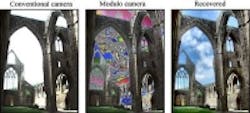Researchers develop method to prevent cameras from overexposing an image
A team of researchers fromMassachusetts Institute of Technology (MIT) and the Singapore University of Technology and Design have developed a technique based on computational photography which enables camera sensors to reset when there is an excess of light in the field of view, thereby protecting the image from the effects of overexposure.
Traditionalhigh dynamic range (HDR) photography, according to SPIE, falls into two categories: multi-capture and single-capture fusion. In multi-capture fusion, several images are taken at different exposure levels, and then fused together. With this method, imaging moving objects can be difficult, and any movement of the camera can lead to poor results. Oftentimes, a deghosting’ technique (removing the transparency) is usually necessary.
Single-capture fusion requires a camera that has different exposure time from pixel to pixel. This technique has been adopted by Sony and Fujifilm with a number of camera models, but even though it is possible to obtain an HDR image in a single shot with this technique, there are often a number of over- or underexposed pixels. As a result, the spatial resolution is negatively affected. The technique utilized by this team of researchers involves tweaking the sensor circuit to protect the camera from overexposure.
The team’s "modulo camera," resets the sensor capacitors whenever they get full, with each pixel of the camera sensor getting a reset controller. During exposure time, when a sensor capacitor is filled, a reset signal is sent to discharge the capacitor of the pixel (or clear the pixel value). With this method, the pixel is always ‘active’ during exposure. If the ground truth signal value is a large number that can be represented by a long string of binary digits, our camera only takes the least significant bits, according to the researchers, who provided an example:
With an eight-bit camera sensor (a bit depth of 8), whenever a pixel is filled with 8 bits of information, its capacitor is reset to zero and starts another round of filling. At the end of exposure, this modulo camera keeps the least significant eight-bit information of all of the pixels. Comparably, a conventional camera gives eight 1s, which results in many white pixels. Therefore, our approach preserves more information during capturing. This resetting function is exactly the same as a modulo operation in mathematics, hence the name ‘modulo camera’ for our approach.
In order to ensure that no modulo fringes (artifacts) are left, the team applied an inverse modulo (or unwrapping) algorithm, and the result is an image without overexposure. The algorithm, according to the team, would enable users to simply click a camera button and let the computer deal with overexposure issues.
Future work will focus on applying real-time HDR camera to real-world applications. The research team consisted of Hang Zhao, Christy Fernandez-Cull, Ramesh Raskar (MIT), Boxin Shi, and Sai-Kit Yeung (Singapore University of Technology and Design)
View theresearch paper.
View the SPIE article.
Share your vision-related news by contactingJames Carroll, Senior Web Editor, Vision Systems Design
To receive news like this in your inbox,click here
Join ourLinkedIn group | Like us on Facebook | Follow us on Twitter| Check us out on Google +
About the Author

James Carroll
Former VSD Editor James Carroll joined the team 2013. Carroll covered machine vision and imaging from numerous angles, including application stories, industry news, market updates, and new products. In addition to writing and editing articles, Carroll managed the Innovators Awards program and webcasts.
